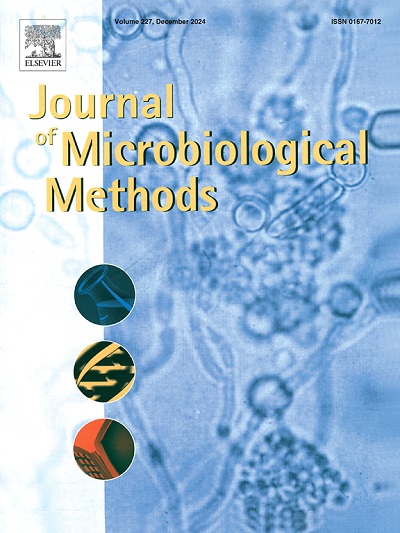基于深度学习的分类器快速计数酵母中粗粒哈萨克菌和酿酒酵母
IF 1.9
4区 生物学
Q4 BIOCHEMICAL RESEARCH METHODS
引用次数: 0
摘要
当通过倒洗来维持酵母时,面包师必须确保酵母菌群保持稳定。通过引入两阶段孵育温度进行培养,我们发现humilis Kazachstania和酿酒酵母(Saccharomyces cerevisiae)菌落可以通过大小和颜色进行区分。然后我们开发了一个分类器,使用深度学习方法YOLO来自动计数这些菌落。对于酵母分离株,该分类器的准确率分别为0.99和0.98。该分类器对面包、清酒和葡萄酒中使用的酿酒酵母菌株的准确率也大于0.95。为了研究酵母发酵的可行性,在25°C、30°C和35°C的条件下,通过反复倒灌来刷新酵母,以人为地波动酵母菌群。在25°C条件下,黄乳杆菌和酿酒酵母所占比例分别约为25%和75%,而在30°C和35°C条件下,黄乳杆菌所占比例不到1%。该分类器的准确率分别为0.98和0.99;这与人工计数获得的准确性非常接近,表明分类器可以检测到酵母菌群的变化。分类器花了大约126毫秒来计数一个培养皿上的菌落。使用我们的新型分类器可以实现快速,省力,客观的判断,潜在地促进小规模工匠面包店管理发酵的能力,每天的基础上。本文章由计算机程序翻译,如有差异,请以英文原文为准。
Rapid counting of Kazachstania humilis and Saccharomyces cerevisiae in sourdough by deep learning-based classifier
When maintaining sourdough through backslopping, bakers must ensure that the yeast mycobiota remains stable. By introducing two-staged incubation temperatures for cultivation, we found that the colonies of Kazachstania humilis and Saccharomyces cerevisiae could be differentiated by size and color. We then developed a classifier that used the deep-learning method, YOLO, to automatically count these colonies. For sourdough isolates of K. humilis and S. cerevisiae, the classifier had accuracies of 0.99 and 0.98, respectively. This classifier also showed accuracies greater than 0.95 for S. cerevisiae strains used in bread, sake, and wine. To investigate the practical feasibility, the sourdough was repeatedly refreshed by backslopping at 25 °C, 30 °C, and 35 °C, with the goal of artificially fluctuating the yeast mycobiota. At 25 °C, K. humilis and S. cerevisiae accounted for proportions of approximately 25 % and 75 %, respectively, whereas at 30 °C and 35 °C, K. humilis comprised less than 1 % of the mycobiota. The accuracy of this classifier was 0.98 for K. humilis and 0.99 for S. cerevisiae; this was very close to the accuracy obtained with manual counting, indicating that the classifier could detect changes in the yeast mycobiota. The classifier took approximately 126 milliseconds to count colonies on one Petri dish. The use of our novel classifier can enable fast, less-laborious, and objective judgement, potentially facilitating the ability of small-scale artisan bakeries to manage fermentation on a daily basis.
求助全文
通过发布文献求助,成功后即可免费获取论文全文。
去求助
来源期刊

Journal of microbiological methods
生物-生化研究方法
CiteScore
4.30
自引率
4.50%
发文量
151
审稿时长
29 days
期刊介绍:
The Journal of Microbiological Methods publishes scholarly and original articles, notes and review articles. These articles must include novel and/or state-of-the-art methods, or significant improvements to existing methods. Novel and innovative applications of current methods that are validated and useful will also be published. JMM strives for scholarship, innovation and excellence. This demands scientific rigour, the best available methods and technologies, correctly replicated experiments/tests, the inclusion of proper controls, calibrations, and the correct statistical analysis. The presentation of the data must support the interpretation of the method/approach.
All aspects of microbiology are covered, except virology. These include agricultural microbiology, applied and environmental microbiology, bioassays, bioinformatics, biotechnology, biochemical microbiology, clinical microbiology, diagnostics, food monitoring and quality control microbiology, microbial genetics and genomics, geomicrobiology, microbiome methods regardless of habitat, high through-put sequencing methods and analysis, microbial pathogenesis and host responses, metabolomics, metagenomics, metaproteomics, microbial ecology and diversity, microbial physiology, microbial ultra-structure, microscopic and imaging methods, molecular microbiology, mycology, novel mathematical microbiology and modelling, parasitology, plant-microbe interactions, protein markers/profiles, proteomics, pyrosequencing, public health microbiology, radioisotopes applied to microbiology, robotics applied to microbiological methods,rumen microbiology, microbiological methods for space missions and extreme environments, sampling methods and samplers, soil and sediment microbiology, transcriptomics, veterinary microbiology, sero-diagnostics and typing/identification.
 求助内容:
求助内容: 应助结果提醒方式:
应助结果提醒方式:


